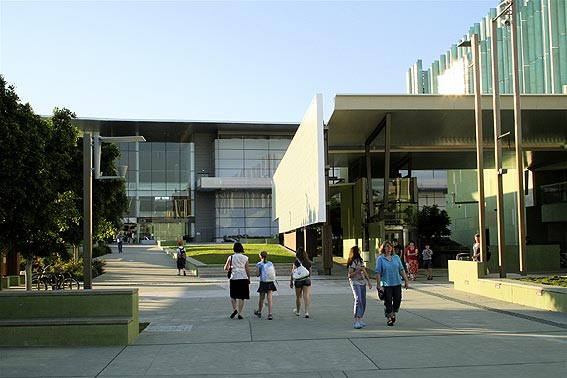
Gallery of Modern Art
[Photograph by Trevor Bunning (October 2007)]

Gallery of Modern Art
[Photograph by Trevor Bunning (October 2007)]
Historical and Technical Documentation by Geoffrey Cox
© OHTA 2007, 2011, 2013 (last updated May 2013)
The Gallery of Modern Art was opened in December 2006 to complement the nearby Queensland Art Gallery, which had moved to its present location on the South Bank of the Brisbane River in 1982. The new gallery was designed, following an architectural selection competition in 2002, by the Sydney-based company, Architectus.1
The organ in this location was originally installed in 1929 in the Regent Theatre, Queen Street, Brisbane, where it remained until 1964. After a period in private ownership in the Blue Mountains, NSW, it was returned to Queensland in 2004 and opened in its present location in 2007. Hardly altered at all over the years, it remains an important part of Queensland's cultural heritage.2
Opened on 8 November 1929, the Regent Theatre was the most magnificent entertainment building of its kind in Queensland. It survived intact until 1979, but only the entry foyer and marble staircase have survived. These now serve the Hoyt's Entertainment Centre, a four-cinema complex opened in August 1980.3

The interior of the Regent Theatre, Brisbane, c.1955
[Photograph: John Oxley Library, State Library of Queensland]
The Regent was the second of two Brisbane city theatres to install a theatre pipe organ built by the Wurlitzer Co. of Tonawanda, N.Y. in the USA, the earlier instrument having been installed five years beforehand at the nearby Wintergarden Theatre.4 The Regent instrument (Wurlitzer's Opus 2040) was by far the larger of the two, comprising 15 ranks & percussion spread over three manuals and pedals. It left the factory on 11 March 1929, and was the last new Wurlitzer organ to be sent to Australia.5
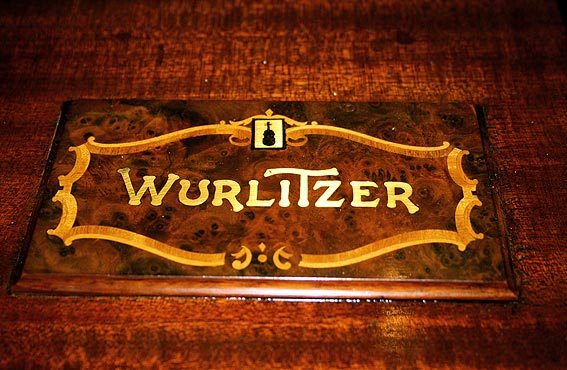
The builder's nameplate on the organ
[Photograph by Trevor Bunning (October 2007)]
The reported cost of the organ was £25,000. Following its arrival in Brisbane, it was photographed on the morning of Tuesday 17 September 1929 being transported in ceremonial style to the theatre in a procession of ten lorry-loads of crates.6
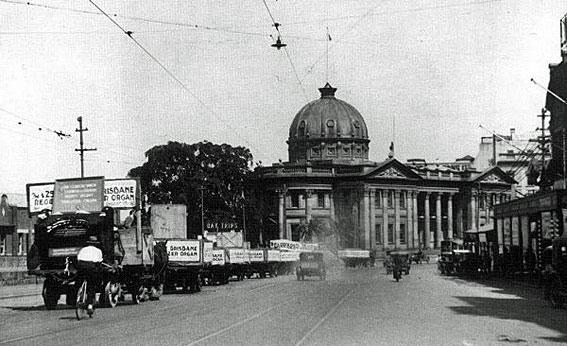
[Photograph: The Telegraph, 2nd edition (17 Sept 1929), p. 3.]
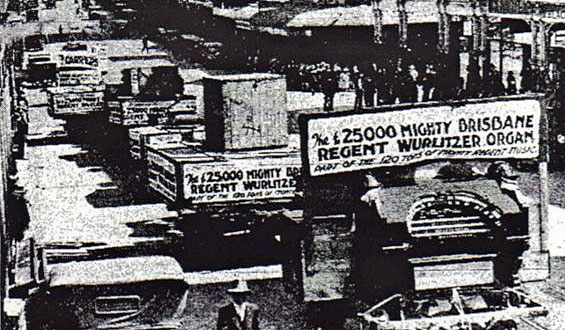
Procession of the Regent Theatre organ through the streets of Brisbane
[Photograph: The Brisbane Courier (18 Sept 1929), p. 20.]
A description of the organ and of the procession through the streets appeared in The Telegraph as follows:
New Regent Theatre
Transport of Great Organ
Confidence in the future of Queensland prompted Hoyt's Theatres Limited to extend its picture show activities to Brisbane.
This morning 10 lorry-loads of plant intended for the construction of the Wurlitzer organ which is to adorn the new Regent Theatre in Queen Street passed in procession through the main thoroughfares of Brisbane.
The lorries commenced the parade at the Exhibition and slowly wended their way through Brunswick Street to Queen Street, thence to George Street through Roma Street to the Central Railway Station. The return tour was made by way of Albert and Adelaide Streets to Wharf Street, then along Elizabeth Street to the New Regent Theatre, where the 120 tons of parts for the Wurlitzer organ were unloaded to await installation in the theatre.
THE ORGAN DESCRIBED
The Wurlitzer organ, it is stated, cost £25,000, and is the most expensive instrument of its type so far installed in Australia. It is also claimed that it is the largest and most replete organ possessed by any theatre organisation in Australia. The organ, which will be installed by Mr. D. E. Dodd, representing the makers, contains 500 miles of electric wiring and has over 2,000,000 separate electric contacts, each contact being of sterling silver. It is estimated that over 15 cwt. of silver was used. The wind for the organ is generated by four stage blowers driven by a 15 h.p. motor, which raises 32 tons of wind a minute when the organ is being played fortissimo. The largest pipe in the organ is 32 feet in length and is 3 feet 6 inches in diameter. The smallest pipe is less than 1/4-inch in height, with a diameter slightly more than that of a pin point. Mr. Dodd said that 12 pipes placed above the ceiling of the theatre weigh over 10,000 lbs. These require a special steel structure to sustain not only the weight but the colossal vibration of the pipes.
The console of the organ contains three manuals, an independent pedal clavier, and 169 stops, together with many "picture" controls. At the touch of the performer seated at this console the mighty instrument peals forth its pleasing music. It is claimed that the new Regent Theatre organ is capable of producing every known sound.
Mr. Dodd referred to the capable manner in which the transport was carried out by R. Jackson, Limited.7
It is clear from this report that installation was carried out under the supervision of D.E. Dodd, one of the sons of the Adelaide organbuilder, J.E. Dodd. Dodd's only other known work in Queensland was the installation of the Wurlitzer organ at the Wintergarden Theatre earlier in the 1920s. A plate on the Regent console recorded that the instrument was 'Imported and installed by W.A. Crowle, 105 York Street Sydney,' but it is clear also, not least from the photographs below (supplied by Howell Whitehouse), that the firm of Whitehouse Bros, Brisbane, was also involved in the installation.8 W.A. Crowle of Sydney was Wurlitzer's agent in Australia:

Advertisement by W.A. Crowle
[The Brisbane Courier (8 November 1929)]
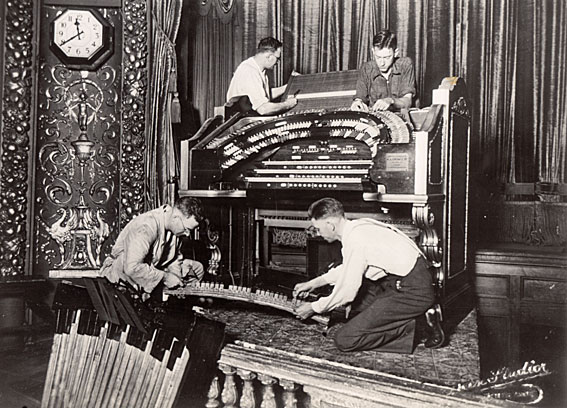
Installation of the Wurlitzer console at the Regent Theatre in 1929
by the staff of Whitehouse Bros (clockwise from top left:
Arthur Langham, Les Langham, Les Somerville & Joe Whitehouse)
[Photograph supplied (with identifications) by Howell Whitehouse (2010)]
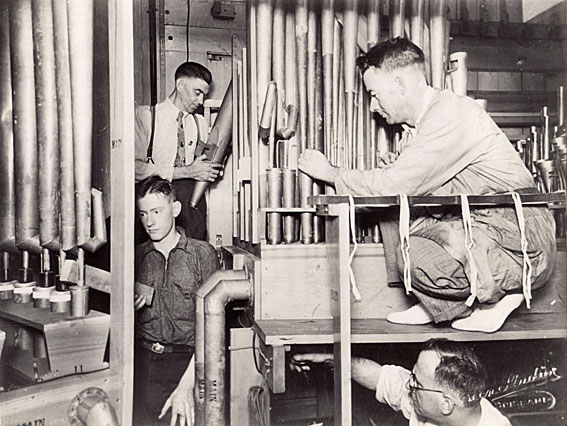
Inside the main chamber of the organ at the Regent Theatre in 1929
Staff of Whitehouse Bros (clockwise from top left:
Les Somerville, Joe Whitehouse, Arthur Langham and Les Langham)
[Photograph supplied (with identifications) by Howell Whitehouse (2010)]
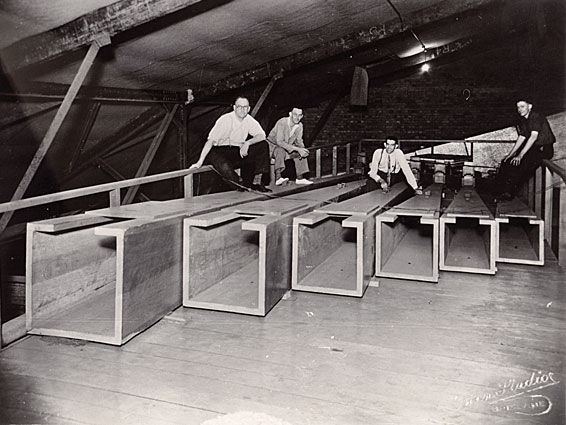
Pipes of the Diaphone 32ft above the ceiling of the Regent Theatre organ in 1929
Staff of Whitehouse Bros (left to right:
Arthur Langham, Joe Whitehouse, Les Somerville and Les Langham)
[Photograph supplied (with identifications) by Howell Whitehouse (2010)]
The Regent instrument has been identified as an example of the Wurlitzer Style 260, its fifteen ranks originally divided between two chambers on either side of the proscenium:
| SOLO CHAMBER Trumpet Tibia Clausa Kinura Orchestral Oboe Saxophone String Oboe Horn Quintadena Percussions (excluding the Chrysoglott) Effects |
MAIN CHAMBER Diaphonic Diapason Tuba Horn Clarinet Viol d’Orchestre Viol Céleste Flute Vox Humana Chrysoglott |
By October 1929, the reported cost of the organ had risen:
£30,000 ORGAN FOR "REGENT."
In the intricate mechanism of the great Wurlitzer Organ which will form a most valuable addition to the orchestra of the new Regent, in Queen street, which is being erected by Hoyts Theatres Limited, at a cost of £300,000, 600 miles of wire have been used. Each of these wires is of sterling silver, and the total cost of the instrument is nearly £30.000. . . . Numerous novelties in organ construction have been introduced. These include a perfect representation of the orchestral bass trumpet saxophones, and oboes. Light and unusual comedy effects are lent by the kinura, which is regarded as the "Charlie Chaplin" of the organ. The primary service which this organ will render will be the rendition of some of the finest music of well-known composers.9
It has been observed that the specification of the Regent organ differed from other Style 260 Wurlitzers in Australia in having a wider range of couplers, and also in that the Tibia rank was extended higher than normal, making it available at 2-2/3ft and 2ft pitches. The Regent organ also had an additional balanced swell pedal to control the expression and sustain mechanisms on the grand piano, which was playable from the organ console.10
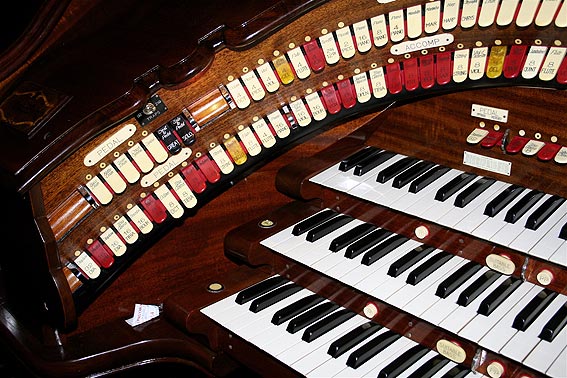
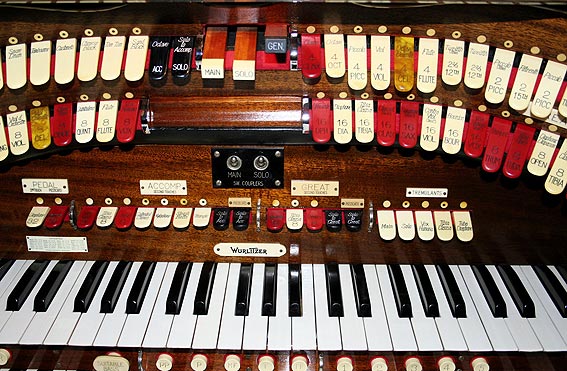
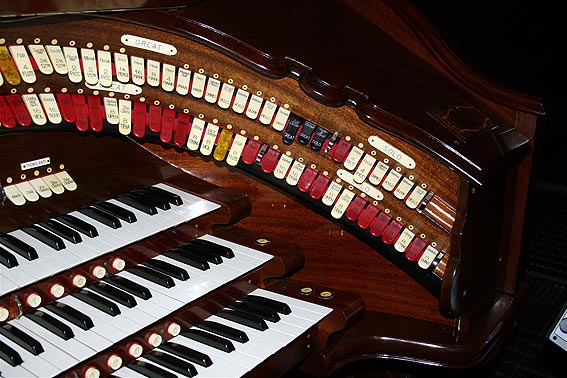
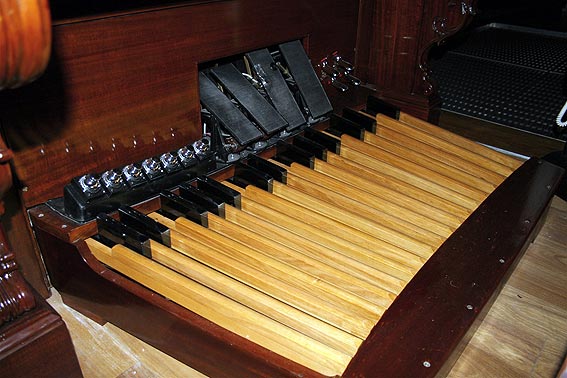
Details of the organ console
[Photographs by Trevor Bunning (October 2007)]
| GREAT | ACCOMPANIMENT | |||
| Ophicleide | 16 |
Contra Viol TC | 16 |
|
| Diaphone | 16 |
Bourdon | 16 |
|
| Tibia Clausa | 16 |
Vox Humana TC | 16 |
|
| Clarinet TC | 16 |
Tuba Horn | 8 |
|
| Saxophone TC | 16 |
Diaphonic Diapason | 8 |
|
| Contra Viol | 16 |
Tibia Clausa | 8 |
|
| Bourdon | 16 |
Clarinet | 8 |
|
| Vox Humana TC | 16 |
Kinura | 8 |
|
| Trumpet | 8 |
Orchestral Oboe | 8 |
|
| Tuba Horn | 8 |
Saxophone | 8 |
|
| Diaphonic Diapason | 8 |
String | 8 |
|
| Tibia Clausa | 8 |
Viol d’Orchestre | 8 |
|
| Clarinet | 8 |
Viol Céleste | 8 |
|
| Kinura | 8 |
Oboe Horn | 8 |
|
| Orchestral Oboe | 8 |
Quintadena | 8 |
|
| Saxophone | 8 |
Flute | 8 |
|
| String | 8 |
Vox Humana | 8 |
|
| Viol d'Orchestre | 8 |
Octave | 4 |
|
| Viol Céleste | 8 |
Piccolo | 4 |
|
| Flute | 8 |
Viol | 4 |
|
| Vox Humana | 8 |
Octave Céleste | 4 |
|
| Clarion | 4 |
Flute | 4 |
|
| Octave | 4 |
Vox Humana | 4 |
|
| Piccolo | 4 |
Twelfth | 2-2/3 |
|
| Viol | 4 |
Piccolo | 2 |
|
| Octave Céleste | 4 |
|||
| Flute | 4 |
Piano | 16 |
|
| Twelfth (Tibia) | 2-2/3 |
Piano | 8 |
|
| Twelfth | 2-2/3 |
Piano | 4 |
|
| Piccolo (Tibia) | 2 |
Mandolin | ||
| Fifteenth | 2 |
Marimba | ||
| Piccolo | 2 |
Harp | ||
| Tierce | 1-3/5 |
Chrysoglott | ||
| Piano | 16 |
Snare Drum | ||
| Piano | 8 |
Tambourine | ||
| Piano | 4 |
Castanets | ||
| Marimba | Chinese Block | |||
| Harp | Tom Tom | |||
| Cathedral Chimes | Sand Block | |||
| Sleigh Bells | ||||
| Xylophone | Solo to Accompaniment | |||
| Glockenspiel | ||||
| Orchestral Bells | ||||
| Chrysoglott | ||||
| ACCOMP. 2nd TOUCH | ||||
| Sub Octave | Tuba Horn | 8 |
||
| Octave | Tibia Clausa | 8 |
||
| Solo to Great | Clarinet | 8 |
||
| Cathedral Chimes | ||||
| GREAT 2nd TOUCH | Xylophone | |||
| Ophicleide | 16 |
Sleigh Bells | ||
| Tibia Clausa | 8 |
Triangle | ||
| Clarinet | 8 |
|||
| Solo to Great | Solo to Accompaniment | |||
| Great Pizzicato | Accompaniment Pizzicato | |||
| SOLO | PEDAL | |||
| Ophicleide | 16 |
Diaphone | 32 |
|
| Diaphone | 16 |
Ophicleide | 16 |
|
| Tibia Clausa | 16 |
Diaphone | 16 |
|
| Trumpet | 8 |
Tibia Clausa | 16 |
|
| Tuba Horn | 8 |
Bourdon | 16 |
|
| Diaphonic Diapason | 8 |
Tuba Horn | 8 |
|
| Tibia Clausa | 8 |
Octave | 8 |
|
| Clarinet | 8 |
Tibia Clausa | 8 |
|
| Kinura | 8 |
Clarinet | 8 |
|
| Orchestral Oboe | 8 |
Saxophone | 8 |
|
| Saxophone | 8 |
String | 8 |
|
| String | 8 |
Cello | 8 |
|
| Oboe Horn | 8 |
Flute | 8 |
|
| Quintadena | 8 |
Flute | 4 |
|
| Clarion | 4 |
Piano | 16 |
|
| Octave | 4 |
Bass Drum | ||
| Piccolo | 4 |
Kettle Drum | ||
| Cathedral Chimes | Snare Drum | |||
| Xylophone | Crash Cymbal | |||
| Glockenspiel | Cymbal | |||
| Orchestral Bells | Great to Pedal | |||
| Solo to Pedal | ||||
| EFFECTS | ||||
| Fire Alarm | PEDAL 2nd TOUCH | |||
| Horse Hoofs | Diaphone | 32 |
||
| Surf | Percussions available on first or | |||
| Bird Whistle | second touch by tumbler switch | |||
| Boat Whistle | Pedal Pizzicato Touch | |||
| Klaxon Horn | Ophicleide | 16 |
||
| Door Bell | ||||
ACCESSORIES
Tremulant - Main Organ (Clarinet, Viol, Céleste, Flute)
Tremulant - Solo Organ (Trumpet, Kinura, Orch Ob, Sax, String, Ob Hn, Quintadena)
Tremulant - Diaphone, Tuba
Tremulant - Tibia Clausa
Tremulant - Vox Humana
Balanced crescendo pedal to Solo chamber
Balanced crescendo pedal to Main chamber
Balanced crescendo pedal to Piano (and General pedal)
Balanced General Crescendo pedal
10 combination pistons to each manual
3 toe pistons to pedal stops
Suitable Bass and release pistons to each manual
Console lift controls: Up Down Stop.11
Compass: 61/32
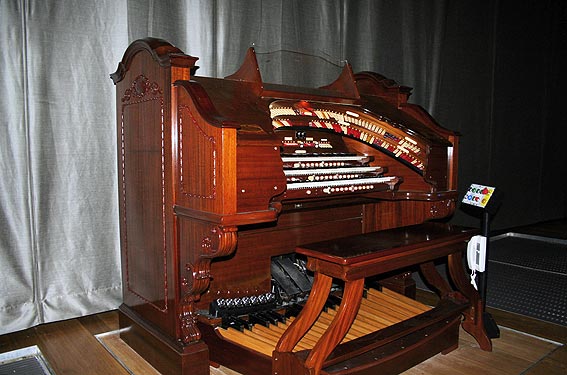
The restored Wurlitzer console
[Photograph by Trevor Bunning (October 2007)]
The elegant console of the organ, with its curved side pillars in the 'French' style, was initially placed at the Regent Theatre on an electrically operated lift to the left of the orchestra.12 In June 1944, Whitehouse Bros were responsible for moving the console at a cost of £82.13 By this time the orchestra at the Regent had been disbanded, and the organ console (by now painted white) was placed on the original orchestra lift in the centre of the pit, flanked by the Chrysoglott and the white-painted grand piano, on the left and right, respectively.14
A further change of arrangements was made in February 1954, when the Whitehouse firm carried out 'removal & inst[allation] of piano on organ' at a cost of £101.15.9.15 This involved the removal of the piano to the small lift at the left of the pit, on which the organ console had originally been placed, and returning the Chrysoglott to the main organ chamber.16
As was the case in the other Australian theatres in which Wurlitzer organs were installed, American organists were initially appointed as 'resident organist.' Their place was eventually taken at the Regent, however, by Melbourne-born Les Richmond, who played there over a period of more than thirty years. Richmond had come to Brisbane initially for the opening season at the Regent as pianist and arranger for the orchestra. In 1930 he studied with the visiting American organist, Eddie Ford, and graduated to the position of 'relief organist' before being offered the job of resident organist. Playing first for silent movies, and later at the 'talkies,' Richmond played frequently for broadcasts from the Regent on ABC radio. He continued playing there until the regular use of the organ ceased around 1962.17 Richmond died in 1973 at the age of 79.18
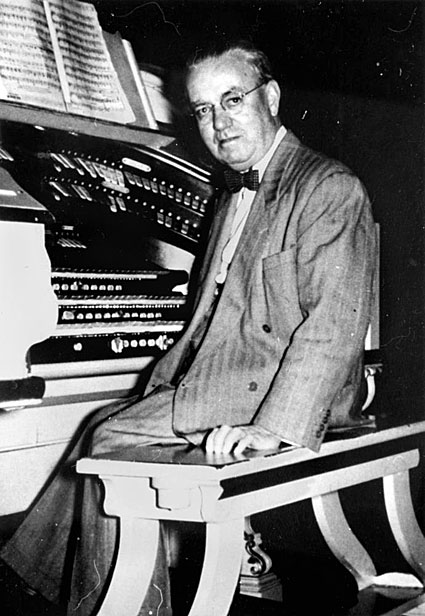
Les Richmond, organist at the Regent Theatre, 1946-c.1962
[Photograph: John Oxley Library, State Library of Queensland]
The Regent Theatre Wurlitzer was sold in 1964 to Dr Keith King, and removed to his residence at Lawson in the Blue Mountains, NSW, where it was installed intact, albeit without the piano. Following Dr King's death, it was purchased by the Queensland Art Gallery with a view to preserving it as an important piece of Queensland's cultural heritage. W.J. Simon Pierce was awarded the contract for installing the organ in its new location, and he removed it from the Blue Mountains in April 2004. The console interior was restored by Don Clark, and the 32ft Diaphone was refurbished by W.J. Simon Pierce. John Andrews of Sydney was the consultant.19
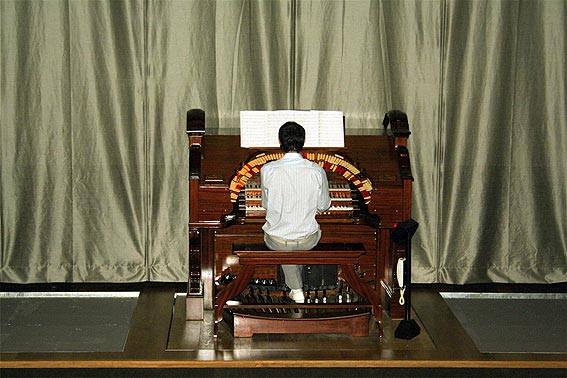
The organ being demonstrated by David Bailey during the 2007 OHTA Conference
with the console on the central lift at the Gallery of Modern Art
[Photograph by Trevor Bunning (October 2007)]
The organ was officially opened in its present location on 29 March 2007, with a performance by Tony Fenelon, including the accompaniment of the feature film, The Story of the Kelly Gang.20 The two main organ chambers are located below the stage, side by side, and the sound of the instrument is conducted into the auditorium through tone chutes that open through grilles in front of the stage. A third chamber (below) contains the wind regulators, tremulants and relays, along with the non-operational electro-pneumatic relays that were retained as 'original material' to be kept with the organ. The bottom octave of the Diaphone 32ft, originally placed above the ceiling in the Regent Theatre, is now placed beneath the floor of the auditorium. The console is placed centrally on a lift that allows it to rise to stage level, and an upright piano placed inside the Solo chamber has been used as a replacement for the original grand piano in the auditorium.
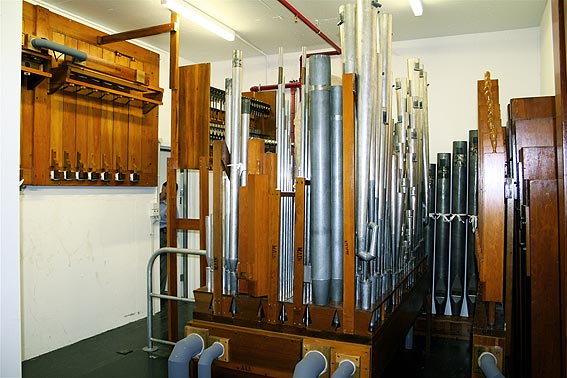
General view of pipework in the Main Chamber
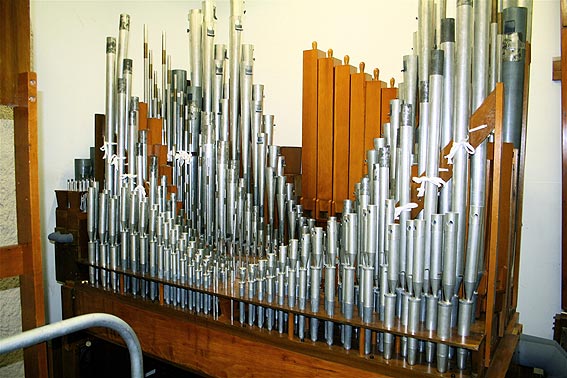
Pipework in the Main Chamber
including the Vox Humana rank at the front of the chest
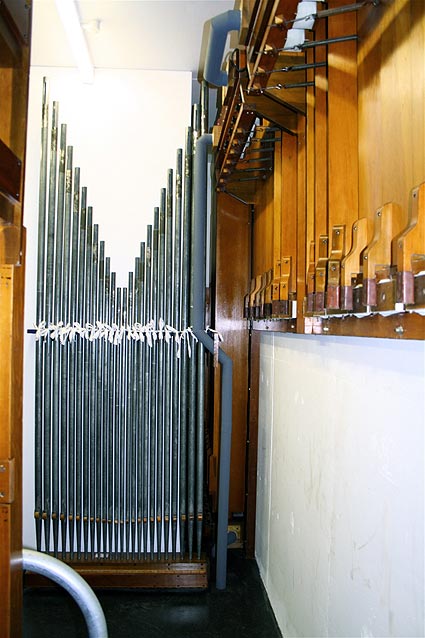
Bass of the string ranks in the Main Chamber
[Photographs by Trevor Bunning (October 2007)]
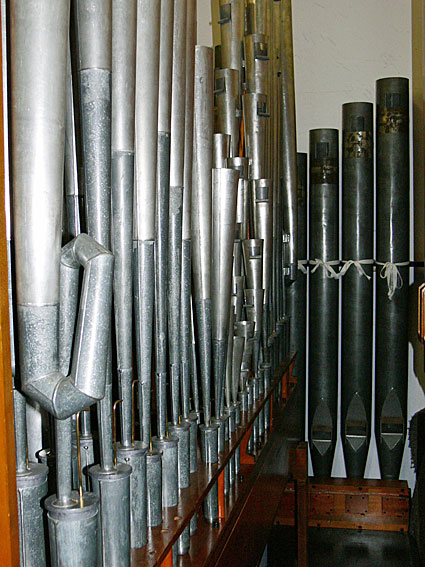
Bass of the Tuba Horn in the Main Chamber
[Photograph by John Maidment (October 2007)]
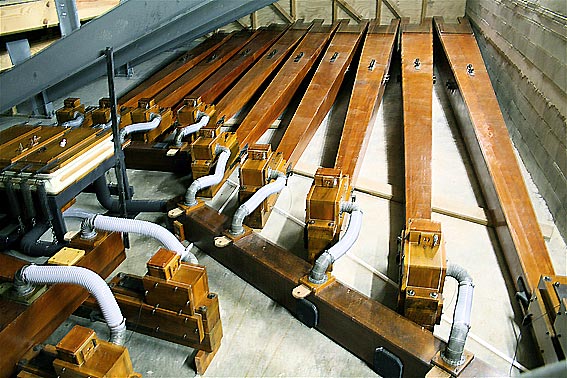
Bass notes of the Diaphone,
placed beneath the floor of the auditorium
[Photograph by Trevor Bunning (October 2007)]
The lower chamber was significantly flooded during the Brisbane floods of January 2011. Although the main chests in the upper chamber escaped, the Tibia 16ft chest was damaged. The tremulants, relays and diaphone chests in the lower chamber were inundated.21 The necessary repairs were completed by Pierce Pipe Organs of Brisbane in November 2011, without requiring the replacement of any original parts.22
_____________________________________________________________________
1 Gallery of Modern Art: Story of a building (South Brisbane, Queensland Art Gallery, 2006); 'Architecture,' from http://qag.qld.gov.au - accessed 11 August 2011.
2 A comparable instrument, also a 'Style 260' Wurlitzer of 3 manuals and 15 ranks, originally in the Regent Theatre, Sydney (1928) but now at the residence of Mr John Atkinson, Hurstville, NSW, has reportedly been placed on the Register of the National Estate (ABC Television News, 24 December 2006).
3 Queensland Heritage Council, Queensland Heritage Register, location 600140.
4 The Wintergarden organ, Op. 748, was of 2 manuals and 7 ranks.
5 Ian McIver, 'Encyclopedia of Australian Theatre Organs,' Theatre Organs under the Southern Cross, http://theatreorgans.com/southerncross - accessed July 2007.
6 The Brisbane Courier (18 September 1929), p. 20.
7 The Telegraph, 2nd edition (17 September, 1929), p. 3.
8 Reg Magee, 'Theatre Organs in Brisbane: Some Reminiscences by Les Langham and Darryl McMullen,' The Organ Voice, vol. 26, no. 4 (December 2000), pp. 30-32.
9 The Brisbane Courier (1 October 1929), p. 24.
10 McIver, op. cit.
11 Specification from McIver, op. cit.
12 McIver, op. cit.
13 Whitehouse Bros Ledger (1940-1954), p. 359.
14 McIver, op. cit.
15 Whitehouse Bros Ledger (1940-1954), p. 12.
16 McIver, op. cit.
17 McIver, op. cit; Lesley Richmond, 'The Wurlitzer Story and Les Richmond,' The Organ Voice, vol. 28, no. 1 (March 2002), pp. 7-11.
18 Obituary in The Courier-Mail (24 December 1973).
19 The Organ Voice, vol. 31, no. 2 (June 2004), p. 24; OHTA News, vol. 29, no. 2 (April 2005), p. 9.
20 The Courier-Mail (28 March 2007); City News (Brisbane, 5 April 2007).
21 Personal communication to OHTA from John Andrews, January 2011.
22 Personal communication to G. Cox from Simon Pierce, October 2012.
Further details regarding this instrument, compiled by Ian McIver, may be found at: http://www.theatreorgans.com/southerncross/Queensland/ModArt.htm